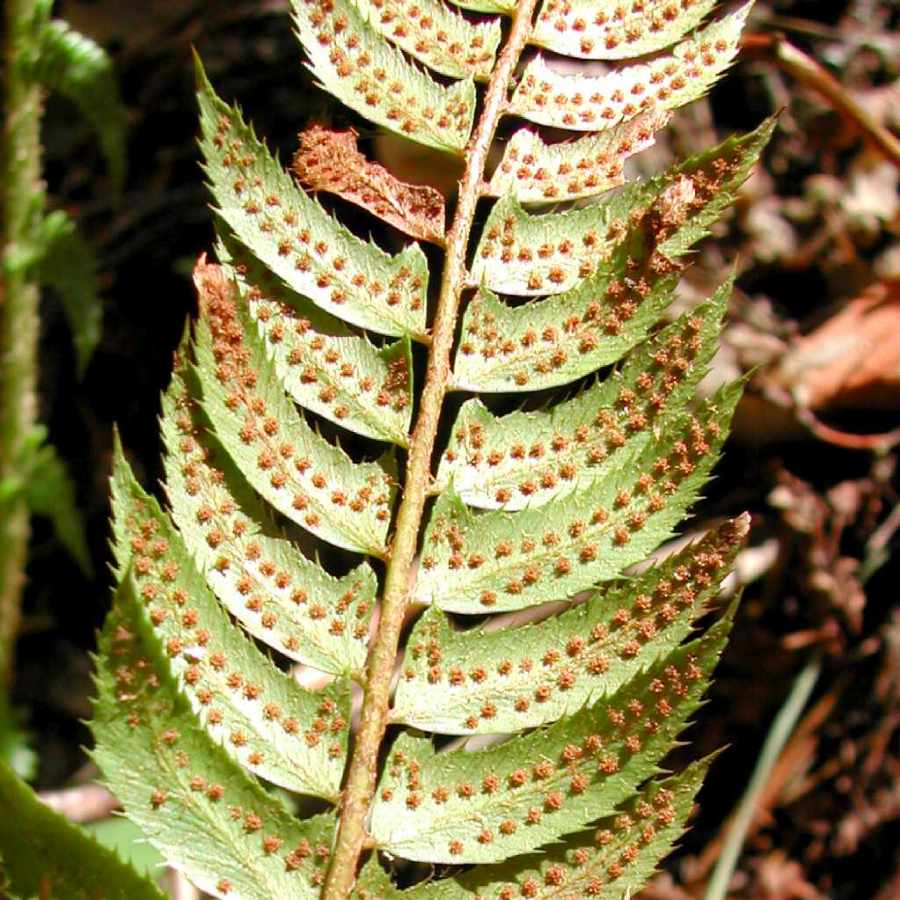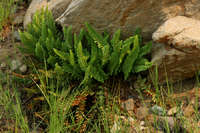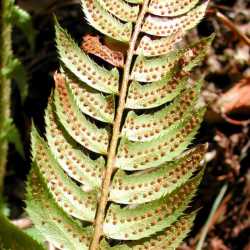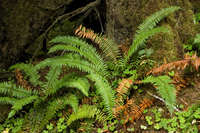Plants terrestrial. Stems decumbent to erect, stolons absent. Leaves monomorphic (dimorphic in P . acrostichoides ), evergreen. Petiole 1/9--1 times length of blade, bases swollen or not; vascular bundles more than 3, arranged in an arc, ± round in cross section. Blade linear-lanceolate to broadly lanceolate, 1--3-pinnate, gradually reduced distally to pinnatifid apex, somewhat leathery to leathery. Pinnae not articulate to rachis, segment or pinna margins spinulose-toothed (except P . lemmonii ); proximal pinnae (several pairs) usually gradually reduced, sessile to short-petiolulate, bases usually inequilateral with acroscopic lobe; costae adaxially grooved, grooves continuous from rachis to costae; indument of linear to lanceolate scales on costae and sometimes between veins abaxially (microscales), ± glabrous or similarly scaly adaxially (scales forming loosely tangled network over blade and sori in P . dudleyi ). Veins free, forked, rarely ( P . imbricans ) anastomosing. Sori in 1 row (to several) between midrib and margins, round (confluent, covering abaxial surface in P . acrostichoides ); indusia peltate, persistent or caducous [absent]. Spores yellow or brownish to black, with inflated folds. x = 41.
The mating systems of Polystichum seem to be highly outcrossing (P. S. Soltis and D. E. Soltis 1987; P. S. Soltis et al. 1989); hybrids are frequent where two or more species occur. Sterile hybrids are discussed under one of their putative parents.
Sterile hybrids are best recognized by their misshapen sporangia, which produce little black dots at the end of the season instead of forming the fuzzy brown bump typical of sori after spores have been expelled. In many cases the intermediacy and robustness of hybrids make them stand out as odd. At least one or two hybrid plants are to be expected in large, mixed populations. The allopolyploids, having hybrid origins, present particular problems. They exhibit the Vavilov effect: allopolyploids tend to resemble one of their parental species when they grow with, or in the habitat typical of, that species (D. S. Barrington et al. 1989).
In the flora there are six diploids, five tetraploids, one hexaploid, and three species whose chomosome number is unknown. Relationships among the diploids are generally not very close; that is, each is probably more closely related to a species outside the flora than to one of the other species in the flora. The exception to this is the group composed of Polystichum acrostichoides , P . imbricans , and P . munitum . Polystichum acrostichoides appears to share a Tertiary common ancestor with P . munitum , and P . imbricans is more recently derived from P . munitum . All of the polyploid species are fertile allopolyploids. One of these species ( P . braunii ) is also involved in the formation of the hexaploid P . setigerum (see below).
Relationships among Polystichum Species
Allopolyploid Presumed Originating Crosses andersonii kwakiutlii × munitum californicum dudleyi × imbricans or dudleyi × munitum kruckebergii lemmonii × lonchitis scopulinum lemmonii × imbricans or lemmonii × munitum setigerum braunii × munitum
The morphological similarity among Polystichum species may make identification difficult, particularly among the species with more divided leaves. The keys presented here are designed for mature, typical individuals. Some of the characters mentioned in the keys and descriptions require the use of a microscope. The microscales (small trichomes that occur on the abaxial leaf surface of all species and adaxially in some) are best observed by peeling them off with cellophane tape and mounting the tape on a slide, sticky side up, under a coverslip. The tape can also be used to lift off the components of the sori. Polystichum acrostichoides , P . andersonii , P . lemmonii , and P . munitum are known to have sclereid clusters in their pith. Polystichum imbricans lacks such clusters, and data are not available for th
Petioles stout, with 4 or 5 vascular bundles, much shorter than the blades, beset with persistent, brownish, notably dimorphic scales, some broad and often toothed or cleft, others small, appressed, hair-like; blade scaly especially on the rachis and costae, otherwise glabrous or occasionally glandular, pinnate to subtripinnate, the principal pinnae subsessile on a narrow, very shortly petiolulate base, the uppermost ones reduced and confluent; pinnae or pinnules spinulose-toothed, mostly subfalcate; veins obscure, free, mostly once-forked; sori borne on the veins in one or more rows on each side of the midrib; indusium peltate, rotund, persistent; ferns with stout, scaly, erect or short-creeping rhizomes and clustered, firm, evergreen lvs. 135, cosmop.
Gleason, Henry A. & Cronquist, Arthur J. 1991. Manual of vascular plants of northeastern United States and adjacent Canada. lxxv + 910 pp.
©The New York Botanical Garden. All rights reserved. Used by permission.









